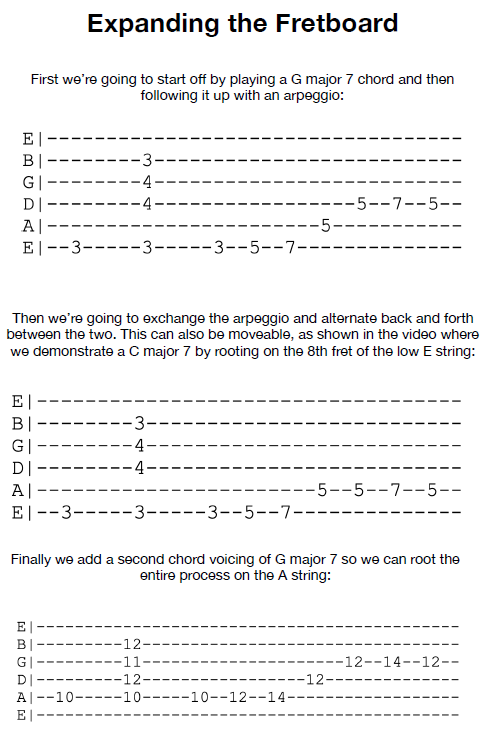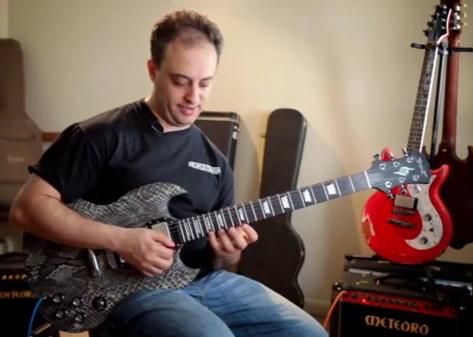[contentwall]  [/contentwall][ninja-popup ID=715]
[/contentwall][ninja-popup ID=715]
What’s going on, everybody, Sean Daniel with, Guitar Control here. Today very, very important lesson because we are combining two concepts that before today were looked at as totally separate, but we’re combining them into one fluid exercise. So click the link below, because I’m going to tab out everything we’re doing here, make it super simple. And basically the exercise is going to look like this.
So all this is, is a scale, a cord and an arpeggio. Now really, I kind of think that the ultimate way to just unlock the fret board is this combination of all these. So the first thing we’re going to do is we’re going to look at a scale and it’s going to be the D minor scale. Okay?
So you may have already seen this. It’s the fifth fret on A string, the seventh fret on the A string, and an eighth fret on the A string. Repeat the exact same thing with the same fingers on the D string. And then repeat almost the exact same thing on the G string. Same fingers, right? So five, seven, eight, five, seven, eight, five, seven. The point here is this is just any minor scale. We just happened to be rooting yet on the D string. The fifth fret on A string is a D, A, A sharp, B, C, C sharp, D. Okay.
So D# minor, would be that E minor is right here, F minor, so on and so forth, right? So that’s great, but really drill that do your hearts desire, because that’s super important shape. But this is a way to kind of like start combining other things about this. Now the third fret in the D minor scale is actually pretty important, the third note in the D minor scale. It’s D, E, F. Okay? Now the reason, the third note in a minor scale is important because that’s actually the key that you’re in. All right? So the key of F major is the same notes as the key of D minor. D, E, F sharp, G, A, B flat, C, D. Same with F. F, G, A, B flat, C, D, E, F. Those are the same notes. One just starts on a D, one starts on an F.
So these scales are really intertwined in a very, very romantic way, because they’re the exact same thing, right? So a D minor chord and an F major chord always go really good together because they’re in that same key. And the next thing we’re going to do is we’re going to find how this F major will connect to what we have so far, right?
So when we have this one octave shape of D minor, we end with your ring finger on the seventh fret of the G string. Now if we went to here, this note, you know what this note is it is, sixth fret on the B string? This is an F note. Okay. So we said the F major was like a super, super companion to the D minor scale. We’re going to take an arpeggio of F major… just like that. Okay. An arpeggio is when you play F major chord, one note at your time. Now the notes in an F major chord, are an F, an A, and a C. Otherwise known in this position as the sixth fret on the B string, the tenth fret on the B string, and the eighth fret of the high E string. Okay.
Now this little jumper here, we’re actually going to pick up a note on the way. Okay, so this is an F, G, A, C. You can almost see this as an extension of the D minor scale… like that, but we’re kind of merging these ideas together. Now where we’re going to go from here… is to finish the arpeggio has you on the next highest F, which is the thirteenth fret and the high E string. You can always count to thirteen by taking me double dot. I’m mostly guitars and going one fret higher thirteenth fret is the same as the first fret.
Okay, so we’re running together two different ideas. Starting on D minor, the scale and ending on an F note. Now the great thing about this is we’re actually going to combine this with another type of D minor scale, a D minor pentatonic scale, that’s going to span all six strings. The cool thing about the D minor scale… is it has all the nodes to complete a full key, but we’re really just doing it inside of one octave. So it only traverses three strings. So the nice thing about having the arpeggio is it advances us through the strings and then it sets us up into the D minor pentatonic shape. which the only difference between minor scale and the minor pentatonic scale is it’s two notes less. Okay.
Now you can kind of see a lot of similarities between this shape… and this shape. In fact, if we did this shape which is down here… there’s the full minor scale. And here is the minor pentatonic scale. So you’ll notice in the minor scale… we’re leaving this out to go pentatonic. The second part of the minor scale. And also one, two, three, four, five, the sixth fret of the minor scale. So it’s just kind of like a watered down version of minor, minor pentatonic. But the great thing about guitars is the minor pentatonic shape just sounds really good. I love how fast I see the word pentatonic. It’s like I’m racing myself to finish it faster and faster every single time I say it.
Minor pentatonic… is a really great guitar shape, super easy to play, always sounds bluesy, sounds great anywhere.
Okay, so we’re going to combine this into this exercise by going D minor all the way through what active into an F major… back through the D minor pentatonic scale. And then we can add on a chord, any D minor chord you want. Or if you want… you could add on an F major chord even though they’re same key what we’re doing is very minor centric. That’s why you’d say this probably in the key of D minor because our total center is based around D, because a lot of these exercises start and end… on D.
Okay, so I think this is a great way to practice because you just get a different view of things. And the great thing since there are no open strings, you can do this absolutely anywhere. And you can start seeing the connections between minor and major stuff.
Like let’s go two frets higher. This is an E and D, D sharp, E. What’s the third note in the key of E minor? Which is the actual parent key that it’s in E, after our G. So in the key of G and the key of E you can always use any of these notes. You can start with that E minor scale, go diagonal, that’s going to give you the G. And then we end up here and then you can walk it back through the pentatonic scale.
So it’s really just kind of like one way to unlock the fret board. And I think a lot of these things will pay off over, time because you just kind of like start to memorize the intervals and the distances between things in your hand. And it really, a lot of playing guitar and playing by ear is really pattern recognition. So the fact that we have a couple of different shapes… and then we’re kind of putting them together like this is really just a way to improve the connection between your fingertips and your ears. Which is really a very, very important part of just kind of advancing your musicianship to the next stage anyways.
So definitely and I hope you like this exercise. Make sure you click that link below to grab the tab, because again the whole thing is tapped out. We’re having it out in D minor if that’s okay with you people, and a check it out. Let us know what you guys think. And then when you’re done with that make sure you click on other of these cool videos we have on the, Guitar Control channel by myself, other great instructors. And we’re always looking for your feedback too. So anything you guys want to see more. If you guys want to see more of this kind of stuff, if you guys want to see more song based stuff, just let us know because we’re always scanning those comments and trying to give you guys what you want. So thanks a lot. I’ll talk to you soon.


